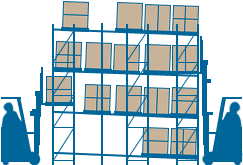
Kornylak Corporation
400 Heaton St.
Hamilton, OH 45011
PH: 513.863.1277
TF: 800.837.5676
F: 513.863.7644
Designing Palletflo® Gravity Flow Storage Rack Systems
Palletflo®
Gravity Racks
• Palletflo
• Additional Info.
• Designing Rails
<< Back
• Wheels
• Accessories
• Brochures
• Case Study
• Pictures
• Video
• Specifications
• Summary
• Quote Request
 Order Online
Order Online
• Information Request
• Product Literature
• Home
Quick Find: More Conveyor Types | More Wheel Types
Palletflo : Accessories | Brochure | Case Study | Design | Details | Photos | Racks | Specs | Summary | Video | Wheels
Kornylak Will Help You Design The Best Palletflo® Gravity Flow Racks
Designing Pallet Flow Storage Rack SystemsPalletflo® rails work with most standard racks. However, the Kornylak Corporation prefers to use structural steel racks or heavy-duty racks in its designs of controlled gravity, live storage systems. Structural steel racks are strong enough to hold beyond the maximum load weight of the rails.

Designing Racks
When designing your pallet flow racks, it is important to consider the placement of all load columns and building openings. Design your loading and unloading zones with enough room to maneuver forklifts. Make sure that a building load column does not block your lane.
The ideal rack depth should be multiples of the load depth plus two feet. So if you wanted 10 loads deep per lane and your load depth is 48" it would be a (10X4')+2' = 42' deep lane. The bay width is figured out by adding 7" total to the load with optional rail guidance or wider without. The bay height is figured out by adding 12" to the load height.
Importance Of Slope Setting
The single most important factor in a pallet flow rack storage system is to correctly adjust the slope during initial installation. The ambient temperature in a warehouse application can very from 60° Fahrenheit to 90° Fahrenheit and flow rates increase at higher temperature and decrease at lower temperatures. The slope adjustment should be set to compensate for this variation. If the installation is carried out during the summer months, set the slope at the highest acceptable speed, since the speed will be slower during the winter months. For winter installations, loads should be blocked in a fixed position overnight or over a weekend and released the next day. If the pallet does not move with a reasonable time, the slope should be readjusted upwards (slightly), until the breakaway occurs after blocking. In other words, slope should be increased or decreased as necessary to obtain a satisfactory flow for the full range of conditions.
For best results, one lane should be setup for testing. A recommended starting slope of .375" per foot of run should be used.
Suggestions to improve our website: Survey
Conveyors | Wheels | Insulation | Vehicles | Products | Literature | Sitemap
Robots | Services | Corporate Facts | Contact Us | FAQ | Info. Request | News
Resources | Links | Directories Links | Organizations Links | Publications Links
Copyright © 1998-2008 Kornylak Corporation